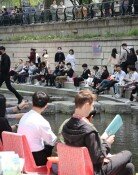Why Do So Many Students Want to Attend Sindorim HS?
Why Do So Many Students Want to Attend Sindorim HS?
Posted January. 16, 2010 07:27,
○ School applications evenly distributed
During construction at Shindorim High School in southwestern Seoul yesterday, the schools Vice Principal Lee Hye-ryeon said a study room for some 200 freshmen was being built.
The Shindorim district of Seoul had no high school until 2008, though residents had long wanted one to be built there. Shindorim High School Principal Oh Se-chang said, It was very burdensome to build a school that could meet residents expectations.
The principal and faculty assigned to the school in January last year had to work in a makeshift office to prepare for the opening, working well past midnight many times.
After its opening, the school endured the typical growing pains of a new educational institution. Some 40 students out of 250 new ones assigned to it wanted not to attend.
Oh phoned them and their parents one by one to persuade them to stay, offering new books as gifts. Most of them changed their minds and stayed, but some chose other schools in the nearby district of Mok-dong.
Shocked by the incident, Oh pondered how to prevent students in her school area from going elsewhere. Her own high school was located near the border between Guro and Yangcheon districts. If allowed to choose the school they want to go to, most students are likely to opt for schools in Mok-dong, which are considered better.
The Shindorim school offered subject-specific classrooms, a large library and brand-new study rooms, but these were not enough for the students to stay. Finally, the principal hit upon an effective strategy for student retention.
Vice Principal Lee said, Our only way was to promote our school. With the new system of allowing students to choose the schools they want to go to, a principal now has to play the role of CEO.
Principal Oh visited each middle school in Mok-dong to promote Shindorim High School. She also held sessions for parents on the schools curriculum, including night sessions for working parents. The sessions attracted strong attention, as more than 200 parents filled the session hall even at night.
Lee said ordinary schools can only survive by offering differentiated courses. Her school offers customized afterschool classes and designated classrooms for math and science. All of the schools teachers are subject to evaluations by students, parents and colleagues.
The effect of word of mouth proved stronger than expected. Small groups of middle school students continued to visit Shindorim High. Teachers volunteered to show them around.
Some 500 students visited the school in just 10 days. One of the schools faculty members said the high competition rate of 17:1 was welcome at a time when the school considered a 3:1 rate sufficient.
○ 85% of students choose nearby schools
According to the Seoul Metropolitan Office of Education, areas where private academic institutes are clustered, such as the Gangnam, Seocho, Nowon and Yangcheon districts in Seoul, showed high rates of competition among middle schoolers who will enter high school this year.
Among school districts, the Jongno, Yongsan and Jung districts of central Seoul showed the highest collective rate of students applying from other districts at 4.9 percent. Gangnam was second with four percent and northern Seoul third with 1.9 percent.
The competition rate in the central Seoul area is three times more than in other areas as it has relatively fewer students compared to the number of schools. In the central area, the number of selected students in the first phase account for 60 percent of the schools quotas. Though the Gangnam area still had a high rate of applicants from outside of the district, one mock application had 18 percent of applicants who were not Gangnam residents another showed 11 percent.
An official at the education office said students and their parents seem to have made discreet decisions in applications in consideration of transportation conditions.
baron@donga.com







